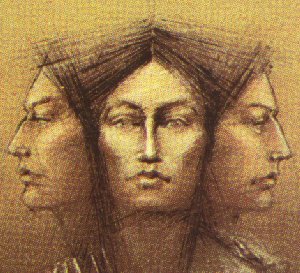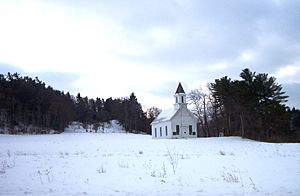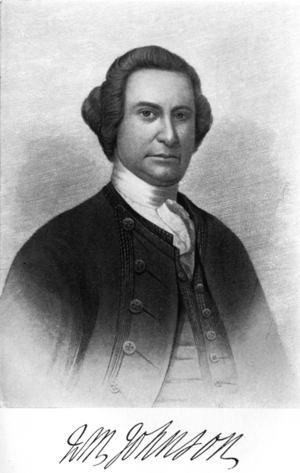Molly Brant facts for kids
Quick facts for kids
Molly Brant
|
|
|---|---|

"The Three Faces of Molly Brant" (Iroquois, European, Loyalist): 1986 design used by Canada Post in a commemorative postage stamp
|
|
| Born | c. 1736 or 1735 Canajoharie on the south bank of the Mohawk River, or Ohio River Valley
|
| Died | April 16, 1796 |
| Resting place | St. Paul's Anglican Church, Kingston |
| Nationality | Mohawk |
| Other names | Mary Brant, Konwatsi'tsiaienni, Degonwadonti |
| Spouse(s) | Sir William Johnson |
| Children | Peter Warren Johnson (1759–1777), seven others |
| Relatives | Joseph Brant, brother |
| Signature | |
Molly Brant (born around 1736 – died April 16, 1796) was an important Mohawk leader. She lived in British New York and later in Canada during the time of the American Revolution. She was also known as Mary Brant, Konwatsi'tsiaienni, and Degonwadonti.
Molly Brant lived with Sir William Johnson, who was a British official in charge of Native American affairs. They had eight children together. Her younger brother, Joseph Brant, also became a famous Mohawk leader.
After Sir William Johnson passed away in 1774, Molly Brant and her children moved back to her home village of Canajoharie. During the American Revolutionary War, she supported the British. She moved to British Canada and helped connect British officials with the Iroquois people.
After the war, she settled in what is now Kingston, Ontario. The British government gave her money and land to thank her for her help. Many Iroquois nations had to leave New York after the war. A special area called the Six Nations Reserve was created for them in what is now Ontario.
Since 1994, Molly Brant has been recognized as a Person of National Historic Significance in Canada. She is also remembered on April 16 by the Anglican Church of Canada.
Contents
Who Was Molly Brant?
Molly Brant was born around 1736. Her birth name was Mary. She was a Christian Mohawk. Historians believe her father's name was Peter. Her brother, Joseph Brant, was born in 1743.
One of Molly's Mohawk names was Konwatsi'tsiaienni. This means "Someone Lends Her a Flower". Her other Mohawk name was Degonwadonti, meaning "Two Against One". These names show her importance in her community.
The Mohawk people are part of the Six Nations of the Iroquois League. They lived in what is now upstate New York. Molly's family moved to the Ohio Country for a time. This area was used by the Iroquois for hunting.
After her father died, Molly's family returned to Canajoharie. Her mother married Brant Kanagaradunkwa, a respected Mohawk leader. Molly and Joseph took his name as their last name. This was not common back then.
Molly grew up in a Mohawk culture that had learned from Dutch and English traders. Her family lived in a large house and used European goods. They attended the Church of England. Molly spoke both Mohawk and English very well.
In 1754, Molly traveled with her stepfather to Philadelphia. They went to discuss a land sale problem. There, she met Captain Staats Long Morris. She was about 19 years old and described as "good looking".
Life with Sir William Johnson

Sir William Johnson was a British official. He often stayed at Molly's stepfather's house in Canajoharie. After Sir William's first partner passed away, Molly moved in with him.
In 1759, Molly gave birth to their son, Peter Warren Johnson. Molly lived with Sir William first at Fort Johnson, then at Johnson Hall after 1763. The British had won the French and Indian War by then.
Molly Brant was like Sir William's common-law wife. She played a big part in running their home. She managed buying things for the house. They had nine children together, and eight lived past infancy.
Their children included:
- Peter Warren Johnson, who served in the British army and died in 1777.
- Six daughters: Elizabeth, Magdalene, Margaret, Mary, Susanna, and Ann.
- George Johnson.
Molly was called Sir William's "housekeeper" in his will. This meant she managed the household and hosted guests. She was known for her intelligence and charm. Sir William used his connection with Molly to help his dealings with the Mohawk and other Iroquois nations. Their relationship was well-known.
Sir William Johnson passed away in July 1774. In his will, he left Molly and their children 25,000 acres of land, money, and slaves. Molly moved back to Canajoharie. She lived comfortably and earned money by trading furs.
Molly Brant and the American Revolution
Molly Brant supported the British during the American Revolutionary War. From her home, she helped people who were loyal to the British escape to Canada. She stayed in Canajoharie for the first two years of the war.
In 1777, British forces attacked New York. They surrounded Fort Stanwix. Molly learned that American soldiers were coming to help the fort. She sent Mohawk messengers to warn the British.
This information helped the British and their Mohawk and Seneca allies. They ambushed the Americans and their Oneida allies at the Battle of Oriskany. The Iroquois people were divided in the war. Some sided with the British, and some with the Americans.
After this battle, the war in the Mohawk Valley became very harsh. The Oneida and American rebels attacked Canajoharie. Molly had to leave quickly, leaving most of her belongings behind. She fled with her children to Onondaga, the main city of the Iroquois Confederacy.
At Onondaga, Iroquois leaders met to decide what to do. Most wanted to help the British. But after the Battle of Saratoga, it seemed the British might lose. A Seneca chief suggested they leave the war. Molly Brant spoke up, reminding them of Sir William Johnson. She convinced them to stay loyal to the British.
Molly's influence came from her connections to Sir William Johnson and her stepfather. Also, women in Iroquois society had more political power than in many other cultures. In the Iroquois system, family lines and social status passed through the mother. Women elders helped choose chiefs. Molly became a respected Mohawk matron.
In late 1777, Molly moved to Fort Niagara. British Major John Butler asked her to come because of her influence. At Niagara, Molly helped connect the British and the Iroquois. She was a valuable diplomat.
In November 1777, Molly's son Peter Johnson was killed while serving in the British army.
In 1779, Molly visited Montreal, where some of her children went to school. She returned to Fort Niagara when the Americans attacked Iroquois villages. Many Iroquois people fled to Carleton Island. Molly went there and continued her work helping her people. The British commander thought her influence was "far superior to that of all their Chiefs put together".
Molly was not happy living in army barracks. So, in 1781, the British built her a house on Carleton Island. She lived there with her children and four slaves for the rest of the war. Throughout the war, Molly Brant was a key negotiator and helper for the Mohawk and Iroquois peoples.
Later Life and Legacy
When the British left Carleton Island in 1783, Molly Brant moved to Cataraqui, which is now Kingston, Ontario. The British government built her a house and gave her money each year. She also received land and money for her losses during the war.
The United States offered Molly money if she would return to the Mohawk Valley. But she refused. The New York government said that Molly and her children, as Native Americans, could not own the land Sir William Johnson left them. This land was then sold to other people.

Molly Brant lived in Kingston for the rest of her life. She was a respected member of the community and a founding member of the local Anglican Church. Her son, George Johnson, became a farmer and teacher. Her daughters married important white men.
Molly Brant passed away in Kingston on April 16, 1796, at about 60 years old. She was buried in St. Paul's Churchyard. The exact spot of her grave is not known.
Molly Brant's legacy is important. Since 1994, Canada has honored her as a Person of National Historic Significance. For a long time, historians in the United States did not give her much attention. But in recent years, people have learned more about her important role in Iroquois society.
Some people have criticized Molly for being too pro-British. They say she played a part in the Iroquois losing land in New York. However, like many male leaders, Molly believed that siding with the British was the best way for the Mohawk and other Iroquois nations to survive. She always put her people first.
Molly Brant is remembered on April 16 in the calendar of the Anglican Church of Canada. There are no known real pictures of her. But an image of her is on a statue in Kingston and on a Canadian stamp from 1986.
Recognition in Kingston
On August 25, 1996, the City of Kingston celebrated Molly Brant Commemoration Day. A statue of Molly Brant was created and placed at Rideaucrest Home in Kingston. This was done to honor her life. The celebration included a church service and a traditional Mohawk ceremony.
The Molly Brant One Woman Opera was first performed in Kingston in 2003. This opera tells Molly Brant's story through music. It has since been made into a full four-act opera.
In 2015, a new elementary school in Kingston was named Molly Brant.


